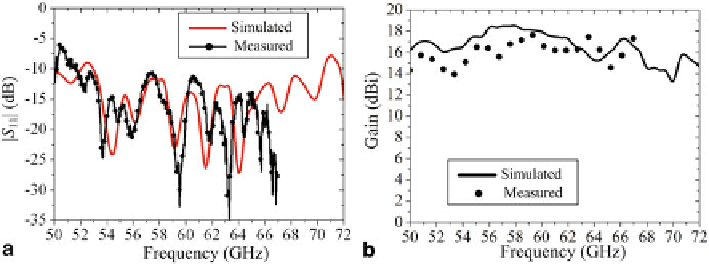Biomedical Engineering Reference
In-Depth Information
Fig. 16
Measured and simulated |
S
11
| and gain of the antenna array with the soft-surface structure.
a
|
S
11
|,
b
Gain and efficiency (from [
10
], reprinted with permission from IEEE)
of the array with the soft-surface structure is from 54.5 to 65.5 GHz. The gain of
the array with the soft-surface structure is about 4 dB higher than that of the array
without the soft-surface structure at 60 GHz. This is because stronger surface wave
introduced by the thicker substrate and high dielectric constant makes the radiation
in the broadside worse for the case without the soft-surface structure. By adding the
soft-surface structure in this design, the surface wave is suppressed significantly.
The measured and simulated co-pol and cross-pol radiation patterns of the L-
probe patch antenna array with the soft-surface structure in two principal planes
(XoZ-plane and YoZ-plane) at the frequencies of 55, 60, and 65 GHz are shown in
Fig.
17
, respectively. The measured HPBW is about 20
◦
in two principal planes at 60
GHz. The measured cross-polarization level is almost 20 dB below the corresponding
co-polarization at 60 GHz. Slight discrepancies between the simulated and measured
results are mainly caused by the fabrication tolerance and possible effect of the test
setup.
A4
4 LTCC L-probe patch linearly polarized antenna array with a novel
soft-surface structure is presented and tested for 60-GHz wireless communication
applications. The introduced soft-surface structure has suppressed the surface wave
significantly. The proposed antenna array features wide impedance bandwidth, high
gain and stable gain bandwidth.
×
60-GHz LTCC Dual-Polarized Antenna array
A 60-GHz dual-polarized 4
4 L-probe patch antenna array based on LTCC tech-
nology is presented. Few efforts have been made for a polarization diversity antenna
which is an important issue in a mobile or portable wireless communication system.
A dual-polarized antenna can provide polarization diversity to reduce the multipath
fading of the received signals or furnish frequency reuse to double the capacities
[
25
-
29
]. A “differential feed” approach is adopted to realize the dual polariza-
tion in this work. The L-probe feed patch antenna is designed and fabricated using
LTCC technology at the 60-GHz band to achieve wideband impedance bandwidth.
A compact multilayer SL feeding network structure is employed to realize the dual
×

Search WWH ::

Custom Search